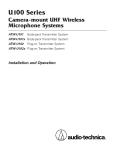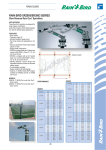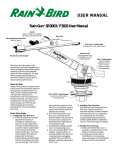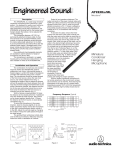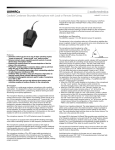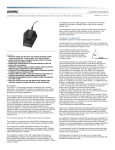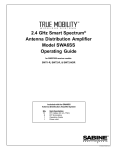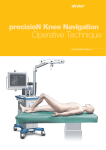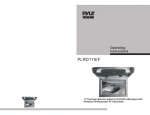Download Audio Technica ATW-U102 Specifications
Transcript
U100 Series Camera-mount UHF Wireless Microphone Systems ATW-U101 Body-pack Transmitter System ATW-U102 Plug-on Transmitter System Installation and Operation U100 Series Camera-mount UHF Wireless Microphone Systems Installation and Operation This device complies with part 15 of the FCC Rules. Operation is subject to the condition that this device does not cause harmful interference. This device complies with INDUSTRY CANADA R.S.S. 210, en conformité avec IC: RSS-210/CNR210. Operation is subject to the following conditions: 1) This device may not cause harmful interference and 2) this device must accept any interference received, including interference which may cause undesired operation. Notice to individuals with implanted cardiac pacemakers or AICD devices: Any source of RF (radio frequency) energy may interfere with normal functioning of the implanted device. All wireless microphones have low-power transmitters (less than 0.05 watts output) which are unlikely to cause difficulty, especially if they are at least a few inches away. However, since a “body-pack” mic transmitter typically is placed against the body, we suggest attaching it at the belt, rather than in a shirt pocket where it may be immediately adjacent to the medical device. Note also that any medical-device disruption will cease when the RF transmitting source is turned off. Please contact your physician or medicaldevice provider if you have any questions, or experience any problems with the use of this or any other RF equipment. CAUTION! The circuits inside the receiver and transmitter have been precisely adjusted for optimum performance and compliance with federal regulations. Do not attempt to open the receiver or transmitter. To do so will void the warranty, and may cause improper operation. Warning: To prevent fire or shock hazard, do not expose this appliance to rain or moisture. Attention: Pour prévenir feu ou choc électrique, ne pas exposé l’appareil à la pluie ou à l’humidité. Introduction Thank you for choosing an Audio-Technica professional wireless system. You have joined thousands of other satisfied customers who have chosen our products because of their quality, performance and reliability. This Audio-Technica wireless system is the successful result of years of design and manufacturing experience. The U100 systems are designed primarily for use in audio-forvideo applications, with the receiver mounted on a camera and connected to the camera’s audio input. U100 systems provide a choice of 100 PLL-synthesized UHF frequencies. Each system includes a receiver and either a body-pack or plug-on transmitter: System Receiver Transmitter ATW-U101 ATW-U102 ATW-R100 ATW-R100 ATW-T101 Body-pack ATW-T102 Plug-on The ATW-R100 receiver features true diversity reception. Two antennas feed two completely independent RF sections on the same frequency; automatic logic circuitry continuously compares and selects the superior received signal, providing better sound quality and reducing the possibility of dropouts. Front-end helical filter design improves rejection of interference. The receiver also offers balanced audio output with level control, a headphone jack with volume control, removable antennas, a hinged battery door, and LED indicators. It operates on two internal 9V batteries or external 12V DC. Each transmitter is powered by one internal 9V battery and has an Off/Standby/On switch, input level control, battery condition indicator and channel selector switches. The ATW-T101 body-pack transmitter has an industry-standard TB5M input connector with both low- and high-impedance inputs plus a bias connection. The ATW-T102 has a 3-pin XLRF-type input connector with a locking collar. Please note that in multiple system applications there must be a transmitter-receiver combination set to a separate frequency for each input desired (only one transmitter for each receiver). Because the operating frequencies of U100 Systems are in UHF TV frequencies, only certain wireless frequencies may be useable in a particular geographic area. Also, only certain of the available operating frequencies may be used together. Suggestions for multiple-system frequency grouping will be found on page 7. 2 Receiver Setup Channel Selector Switches Monitor Headphone Output Jack ANT.A MONITOR X10 9 0 1 28 37 6 5 4 ANT.B PEAK X1 9 0 1 8 7 AF Peak Indicator Antennas Attach the antennas to the antenna input jacks. Make certain that during operation there is a clear open-air path between the receiver antennas and the transmitter. 2 3 6 5 4 PWR A MONITOR LEVEL INT OFF EXT A headphone jack and level control permit monitoring of the audio signal. Either mono or stereo headphones with a 3.5 mm plug may be used; the audio is supplied to both sides of a stereo unit. OUT LEVEL Monitor Output Tuner “A” Headphone Level Antenna Level Control Control Jack Tuner “A” Operation Power Indicator Switch/Indicator B Tuner “B” Antenna Jack Tuner “B” Operation Indicator Fig. A Location The ATW-R100 receiver is designed primarily to be mounted to professional video cameras (mounting methods and positions will vary with the camera being used). However, the receiver will provide outstanding professional performance in other wireless applications as well. For best operation the receiver should be at least three feet above the ground and at least three feet away from a wall or metal surface to minimize reflections. The transmitter should be at least three feet from the receiver. Keep antennas away from noise sources such as computers, motors, automobiles and neon lights; also keep antennas away from large metal objects. Output Connections There is one balanced audio output (31.6 mV) on the back panel of the receiver. Use shielded audio cable to connect this XLRM-type 3-pin jack to the mic audio input of the camera or mixer. Power The ATW-R100 receiver operates on either external DC or internal battery power by setting the Power switch to “EXT” or “INT” respectively (Fig. A). In the center position all power is off. External Power The back panel is equipped with a jack for an external 12-18V DC source, 200 mA nominal current. The jack takes a standard 2.5 mm I.D. coaxial DC power plug, center positive. Battery Selection and Installation Always use two fresh alkaline 9V batteries. Replace the batteries in pairs. Open the hinged battery door on the side of the receiver. Insert two batteries, observing correct polarity as marked on the inside of the door. Close and latch the door. Note that the battery door will not close fully if the batteries are installed incorrectly. Do not force the door closed. The U100 Series receiver and transmitters accept most popular brands of 9-volt alkaline batteries. But there is considerable variation in battery sizes; some alkaline and extended-life batteries may not fit correctly, which can cause units to operate improperly or not at all. 3 Transmitter Setup Input Connector Power Switch (Off/Standby/On) Antenna INPUT ST.BY ATW-T101 BATT ON OFF Fig. B Battery Condition Indicator Transmitter Input Connections Connect a microphone to the audio input connector on the transmitter. ATW-T101 The ATW-T101 body-pack transmitter has an industry-standard TB5M input connector with both low- and high-impedance inputs plus a bias connection. ATW-T101 Input Connections 5 4 1 Battery Compartment Input Level Control (shown set to “Hi”) Channel Selector Switches MIC LVL CHANNEL 3 56 3 56 3 7 3 7 8 2 8 2 109 109 Fig. C Input Connector X10 X1 Lo Hi Power Switch (Off/Standby/On) Battery Condition Indicator BATT OFF STAND BY ON ATW-T102 9 0 1 Hi MIC LEVEL 6 5 4 X10 2 3 8 7 6 5 4 X1 CHANNEL Fig. D Microphone Level Control 3 2 Pin Transmitter Connections Condenser Mic Input Connections Dynamic Mic Hi-Z Line 1 Shield (Ground) Shield/Bias – Shield/Audio “–“ Shield/Audio “–“ 2 Bias + Out Bias + In Open Open 3 Lo-Z Mic In Mic Audio Mic Audio “+” Jumper to Pin 1 4 Source Load (2.2 kV) Jumper to Pin 1 Open Jumper to Pin 1 5 Hi-Z Line In Open Open Line Audio ”+” ATW-T102 The ATW-T102 plug-on transmitter has a 3-pin XLRF-type input connector with a locking collar. To attach the microphone, rotate the threaded locking collar fully clockwise (“down”) until it reaches the transmitter housing (Fig. E1). Then rotate the collar back “up” one or two turns to expose the microphone latch. 9 0 1 2 3 8 7 Lo Channel Selector Switches Battery Selection and Installation Always use a fresh alkaline 9V battery. Press the microphone and transmitter together (Fig. E2), making certain that the latch “clicks” into the base of the mic. Pull on the mic to make certain it is latched on the connector. Continue to rotate the threaded collar “up” until it is firmly against the end of the mic (Fig. E3). Make certain the mic is securely attached before use. To detach the microphone, reverse the steps above. Always loosen the threaded collar fully before attempting to disconnect the mic. Open the hinged battery door. Insert the battery, observing correct polarity as marked inside the battery compartment. Close the battery door. Do not force the door closed. Battery Condition Indicator After the battery is installed, turn the power on. The battery condition indicator LED (Fig. B/D) should flash momentarily. If it does not, the battery is installed incorrectly or it is dead. If the indicator LED stays on (does not flash), the battery voltage is low and the battery should be replaced. If this happens during use, replace the battery immediately to ensure continued operation. “CLICK” E1 Latch E2 Fig. E E3 4 TB5M Connector, Top View ATW-T102 Input Connections Pin 1 Case Ground Pin 2 Audio “+” and 5V DC bias Pin 3 Audio “–” and 5V DC bias Use a dynamic microphone, or a condenser mic with an internal battery. In addition, the ATW-T102 provides a bias voltage of +5V on Pins 2 and 3 which will power some “battery/phantom” mics designed to work at this low voltage. However, the ATW-T102 will not power a “phantom powered” mic which requires the more-typical 12 to 48 volts. Use of the bias voltage will reduce battery life slightly. Presence of the bias voltage will not affect dynamic microphones. Transmitting Antenna The ATW-T101 body-pack transmitter includes a permanentlyattached flexible antenna. For best results, allow the antenna to hang freely and full length from the bottom of the transmitter. If the received signal is marginal, experiment with different transmitter positions on your body; or try repositioning the receiver. Do not attempt to remove, replace or change the length of the transmitting antenna. (The stainless-steel mounting clip may be oriented in one of four “directions.” Loosen its mounting screw, reposition the clip in the case recess as desired and re-tighten the screw.) The ATW-T102 plug-on transmitter’s antenna is housed in a non-metallic section between the metal transmitter case and the mic connector. For best operation, hold the body of the microphone itself and do not cover or obstruct the antenna area. System Operation Setting Channels Use the provided screwdriver to set the channel selector switches on the receiver and transmitter to the same frequency (Fig. A/C/D). As an example, setting the X10 selector on “5” and the X1 selector on “2” designates channel 52, operating at 734.625 MHz as shown on the chart on page 7. Be certain the units are turned off when making frequency changes. Receiver On . . . Turn down the output level of the receiver (OUT LEVEL) and the input level control of the camera or mixer. Turn the receiver on, choosing either “INT” (internal battery) or “EXT” (external DC source) as appropriate. The power indicator LED (PWR) will light up strongly with fresh batteries. (If the LED becomes dim or extinguished, the batteries are weak and should be replaced immediately for reliable operation.) If the tuner operation indicator LEDs (A and B) flicker, there may be RF interference. If this occurs, select another frequency. (Always turn the receiver off when making frequency changes.) Transmitter On . . . Before turning on the transmitter, be certain the transmitter channel selector switches are set to the same numbers as those on the receiver. (–36 dBV) at 1 Pascal/94 dB SPL, while providing excellent signal-to-noise ratios and maximum-acoustic-input levels. 1. Set the transmitter Mic Level control to the full counter-clockwise (Lo) position. 2. Make an initial adjustment of the receiver output and camera/mixer input level controls that will allow audio through the system as you increase the transmitter Mic Level. 3. Plug in the mic and power up the system. 4. While speaking/singing into the microphone at typically-loud levels, increase the transmitter Mic Level adjustment until the maximum audio output of the mic lights the receiver’s Peak indicator. (Do not set the transmitter level too high – doing so will cause the system to overload and distort.) 5. Now, while speaking/singing into the microphone at typically-loud levels, adjust the output level of the receiver so the highest sound pressure level going into the microphone causes no input overload in the camera/mixer, and yet permits the camera/mixer level controls to operate in their “normal” range (not set too high or too low). This provides the optimum signal-to-noise for the entire system. Setting Line Level (ATW-T101) When using a line-level source with the ATW-T101 transmitter, set the input level using the same method given above. The Mic Level (MIC LVL) control adjusts audio gain for both mic and line inputs. The transmitter has a three-position power switch. When the switch is set to “Standby,” (“ST.BY”) the transmitter produces RF with no audio signal. When the switch is “On,” the transmitter produces both RF and audio. With the switch “Off,” there is minimum noise output from the receiver due to a special A-T muting system. RF Interference Please note that wireless frequencies are shared with other radio services. According to Federal Communications Commission regulations, “Wireless microphone operations are unprotected from interference from other licensed operations in the band. If any interference is received by any Government or non-Government operation, the wireless microphone must cease operation . . .” Setting Mic Levels CAUTION! Adjust the Mic Level control carefully. Unlike the Channel Selector switches, it will not rotate continuously! If you need assistance with operation or frequency selection, please contact your dealer or the Audio-Technica professional division. The microphone input accommodates a wide range of mics with typical sensitivity ratings of 1.5 mV (–56 dBV) to 15 mV Extensive wireless information also is available on the Audio-Technica Web site at www.audio-technica.com. Turn the transmitter on. 5 Specifications † Overall System Operating Frequency Number of Channels Frequency Stability Modulation Mode Normal Deviation Operating Range Operating Temperature Range Frequency Response ATW-R100 Receiver Receiving System Image Rejection Signal-to-Noise Ratio Total Harmonic Distortion Sensitivity Intermediate Frequency Audio Output (balanced) Output Connector Monitor Headphone Output (typical) Monitor Headphone Jack External Power Requirements Batteries Current Consumption Battery Life Dimensions Net Weight (without batteries) Accessories Included UHF band, 728.125-740.500 MHz 100 total ±0.005%, Phase Lock Loop frequency control FM ±10 kHz 300' typical (ATW-U102: 200' typical) 41° F (5° C) to 113° F (45° C) 100 Hz to 15 kHz Dual independent receivers, automatic switching diversity 35 dB nominal 107 dB at 30 kHz deviation (IEC-weighted), maximum modulation 75 kHz <1% (10 kHz deviation at 1 kHz) 26 dBmV, (S/N 60 dB at 5 kHz deviation, IEC-weighted) 45 MHz, 10.7 MHz 31.6 mV (at 1 kHz, ±5 kHz deviation, 10k ohm load) 3-pin XLRM-type 75 mW max. at 1 kHz, 1% T.H.D., into 32 ohm (each channel) stereo headphones 3.5 mm TRS, signal on both Tip and Ring 12V DC nominal, 200 mA Two 9V (NEDA type 1604) alkaline, not included 130 mA typical Approximately 5-7 hours (depending on battery type and use pattern) 3.35" (85.0 mm) W x 4.53" ( 115.0 mm) H x 1.42" (36.0 mm) D 12.0 oz (340 grams) Two flexible UHF antennas; control screwdriver ATW-T101 Body-pack Transmitter RF Power Output 50 mW Max Spurious Emissions Under federal regulations Input Connector TB5M Line Input Impedance/Level 100k ohms/3.16V max. input at 1 kHz, 1% T.H.D. Battery 9V (NEDA type 1604) alkaline, not included Current Consumption 50 mA typical Battery Life Approximately 8-10 hours (depending on battery type and use pattern) Dimensions 2.52" (64.0 mm) W x 3.78" (96.0 mm) H x 0.91" (23.0 mm) D Net Weight (without battery) 5.0 oz (143 grams) ATW-T102 Plug-on Transmitter RF Power Output Spurious Emissions Input Connector Battery Current Consumption Battery Life Dimensions Net Weight (without battery) 50 mW Max Under federal regulations 3-pin XLRF-type 9V (NEDA type 1604) alkaline, not included 60 mA typical Approximately 7-9 hours (depending on battery type and use pattern) 1.58" (40.0 mm) W x 4.32" (109.8 mm) H x 1.58" (40.0 mm) D 6.2 oz (177 grams) † In the interest of standards development, A.T.U.S. offers full details on its test methods to other industry professionals on request. Optional Accessory Microphones AT831cT5 Miniature cardioid condenser microphone, terminated with a TA5F connector for use with the ATW-T101 transmitter. Includes clothing clip and windscreen. MT830cT5 Subminiature omnidirectional condenser microphone, terminated with a TA5F connector for use with the ATW-T101 transmitter. Includes clothing clip and windscreens. MT830cT5-TH “Theater” model, same at MT830cT5 except beige color mic and cable for concealment. U100 Series Compatible with 7000 Series Wireless For greater convenience and flexibility, receivers and transmitters in the Audio-Technica U100 Series and 7000 Series are available individually and may be used interchangeably. All are 100-channel, PLL-synthesized UHF units operating on the same frequency-set. Series U100 7000 Receiver ATW-R100 ATW-R73 Description Miniaturized, battery-powered receiver Half-rack-mount, AC-powered receiver Series U100 U100 7000 Transmitter ATW-T101 ATW-T102 ATW-T75 7000 ATW-T76 Description Body-pack transmitter, metal case, TB5M input connector Plug-on transmitter for separate microphone Body-pack transmitter, plastic case, HRS input connector (Requires A-T mics with model numbers ending in “cW.”) Integrated handheld microphone/transmitter For future reference, please record your system information here. 6 Receiver ATW-R100 Serial Number Transmitter ATW-T101 Serial Number ATW-T102 Serial Number Audio-Technica U100 Series UHF Wireless Operating Frequencies U100 Frequency and Channel Designator List Designator Frequency (MHz) TV Channel Designator Frequency (MHz) TV Channel 00 01 02 03 04 05 06 07 08 09 10 11 12 13 14 15 16 17 18 19 20 21 22 23 24 25 26 27 28 29 30 31 32 33 34 35 36 37 38 39 40 41 42 43 44 45 46 728.125 728.250 728.375 728.500 728.625 728.750 728.875 729.000 729.125 729.250 729.375 729.500 729.625 729.750 729.875 730.000 730.125 730.250 730.375 730.500 730.625 730.750 730.875 731.000 731.125 731.250 731.375 731.500 731.625 731.750 731.875 732.000 732.125 732.250 732.375 732.500 732.625 732.750 732.875 733.000 733.125 733.250 733.375 733.500 733.625 733.750 733.875 57 57 57 57 57 57 57 57 57 57 57 57 57 57 57 57 57 57 57 57 57 57 57 57 57 57 57 57 57 57 57 57 57 57 57 57 57 57 57 57 57 57 57 57 57 57 57 50 51 52 53 54 55 56 57 58 59 60 61 62 63 64 65 66 67 68 69 70 71 72 73 74 75 76 77 78 79 80 81 82 83 84 85 86 87 88 89 90 91 92 93 94 734.375 734.500 734.625 734.750 734.875 735.000 735.125 735.250 735.375 735.500 735.625 735.750 735.875 736.000 736.125 736.250 736.375 736.500 736.625 736.750 736.875 737.000 737.125 737.250 737.375 737.500 737.625 737.750 737.875 738.000 738.125 738.250 738.375 738.500 738.625 738.750 738.875 739.000 739.125 739.250 739.375 739.500 739.625 739.750 739.875 58 58 58 58 58 58 58 58 58 58 58 58 58 58 58 58 58 58 58 58 58 58 58 58 58 58 58 58 58 58 58 58 58 58 58 58 58 58 58 58 58 58 58 58 58 47 48 49 734.000 734.125 734.250 58 58 58 95 96 97 98 99 740.000 740.125 740.250 740.375 740.500 59 59 59 59 59 Multi-channel Systems Following are groupings of frequencies suggested for multi-channel wireless systems. Group A: Channels 00, 02, 08, 15, 46, 50, 60 (or 62), 71, 76, 80, 93, 99 - or Group B: Channels 01, 03, 07, 25, 30, 41, 44, 56, 69, 76, 77, 86 For use where TV Channel 57 is operating: Channels 50, 60 (or 62), 71, 76, 80, 93, 99 (from Group A) - or Channels 56, 69, 76, 77, 86 (from Group B) For use where TV Channel 58 is operating: Channels 00, 02, 08, 15, 46, 99 (from Group A) - or Channels 01, 03, 07, 25, 30, 41, 44 (from Group B) For use where TV Channel 59 is operating: Channels 00, 02, 08, 15, 46, 50, 60 (or 62), 71, 76, 80, 93 (from Group A) - or Channels 01, 03, 07, 25, 30, 41, 44, 56, 69, 76, 77, 86 (All of Group B) 7 Ten Tips To Obtain The Best Results 1. Use only fresh alkaline batteries; replace the receiver batteries in pairs. Do not use “general purpose” (carbonzinc) batteries. 2. Position the receiver so that it has the fewest possible obstructions between it and the normal location of the transmitter. Line-of-sight is best. 3. The transmitter and the receiver should be as close together as conveniently possible, but no closer together than three feet. 4. The receiver antennas should be in the open and away from any metal. 5. The transmitter and receiver must be set to the same channel number. 6. Only one transmitter on a given frequency should be “on” at a time. 7. The power switch on the transmitter has three positions: “Off,” “Standby,” and “On.” In the middle “Standby” position, the transmitter sends only RF to the receiver; the audio source is turned off. 8. If the “Out Level” of the receiver is set too high, it may over-drive the input of the camera/mixer or clip the output of the receiver, causing distortion. Conversely, if the receiver output is set too low, the overall signal-to-noise ratio of the system may be reduced. 9. You need to change channels 1) when a strong interference signal is received, 2) when the channel breaks down, or 3) during multiple-system operation in order to select an interference-free channel. Always turn the units off before changing frequencies. 10. Turn the receiver and transmitter off when not in use. Remove the batteries during long-term storage. One-Year Limited Warranty Audio-Technica professional wireless systems purchased in the U.S.A. are warranted for one year from date of purchase by Audio-Technica U.S., Inc. ( A.T.U.S.) to be free of defects in materials and workmanship. In event of such defect, product will be repaired promptly without charge or, at our option, replaced with a new product of equal or superior value if delivered to A.T.U.S. or an Authorized Service Center, prepaid, together with the sales slip or other proof of purchase date. Prior approval from A.T.U.S. is required for return. This warranty excludes defects due to normal wear, abuse, shipping damage, or failure to use product in accordance with the instructions. This warranty is void in the event of unauthorized repair or modification, or removal or defacing of the product labeling. For return approval and shipping information, contact the Service Dept., Audio-Technica U.S., Inc., 1221 Commerce Drive, Stow, Ohio 44224. Except to the extent precluded by applicable state law, A.T.U.S. will have no liability for any consequential, incidental, or special damages; any warranty of merchantability or fitness for particular purpose expires when this warranty expires. This warranty gives you specific legal rights, and you may have other rights which vary from state to state. Outside the U.S.A., please contact your local dealer for warranty details. Audio-Technica U.S., Inc., 1221 Commerce Drive, Stow, Ohio 44224 P51176-B/W ©1999 Audio-Technica U.S., Inc. 330/686-2600 Printed in Japan www.audio-technica.com









